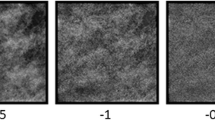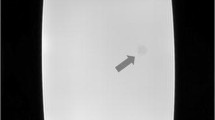Abstract
We introduce a new approach for determining the contrast sensitivity function (CSF) in front of the anatomical noise of mammograms. This permits fundamental investigations on the influence of viewing conditions and image presentation parameters on the perception of contrast. A Gabor pattern and digits are used as target items. The approximation to contrast thresholds is done by a psychophysical staircase procedure and is performed for a selection of spatial frequencies. The results of an observer study with different mammographic cases show, that the approach is applicable independent of the chosen images. For conditions with a duration of at least 3 to 4 minutes the CSF can be determined for a set of spatial frequencies.
Preview
Unable to display preview. Download preview PDF.
Similar content being viewed by others
References
Barten, P.G.J.: Contrast Sensitivity of the Human Eye and Its Effects on Image Quality. SPIE Press Monograph PM72 (1999)
Fletcher-Heath, L., Van Metter, R.: Quantifying the performance of human and software CDMAM phantom image observers for the qualification of digital mammography systems. In: Proceedings of SPIE, vol. 5745, pp. 486–498 (2005)
Burgess, A.E., Jacobson, F.L., Judy, P.F.: Mass Discrimination in Mammography: Experiments Using Hybrid Images. Academic Radiology 10, 1247–1256 (2003)
Strasburger, H.: Indirect Vision. Hogrefe, Göttingen (in German) (2003)
Kaernbach, C.: Adaptive threshold estimation with unforced-choice tasks. Perception & Psychophysics 63(8), 1377–1388 (2001)
Author information
Authors and Affiliations
Editor information
Rights and permissions
Copyright information
© 2008 Springer-Verlag Berlin Heidelberg
About this paper
Cite this paper
Apelt, D., Peitgen, HO. (2008). Contrast Sensitivity in Mammographic Softcopy Reading – Determination with Psychophysical Procedures. In: Krupinski, E.A. (eds) Digital Mammography. IWDM 2008. Lecture Notes in Computer Science, vol 5116. Springer, Berlin, Heidelberg. https://doi.org/10.1007/978-3-540-70538-3_104
Download citation
DOI: https://doi.org/10.1007/978-3-540-70538-3_104
Publisher Name: Springer, Berlin, Heidelberg
Print ISBN: 978-3-540-70537-6
Online ISBN: 978-3-540-70538-3
eBook Packages: Computer ScienceComputer Science (R0)




